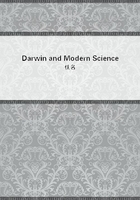
第179章
Those who shrank from either view, gave up the problem as mysterious and beyond the human intellect. This was the expressed opinion of men like Swainson, Lyell and Humboldt. Only Darwin had the courage to say that the problem was not insoluble. If we admit "that in the long course of time the individuals of the same species, and likewise of allied species, have proceeded from some one source; then I think all the grand leading facts of geographical distribution are explicable on the theory of migration...together with subsequent modification and the multiplication of new forms." We can thus understand how it is that in some countries the inhabitants "are linked to the extinct beings which formerly inhabited the same continent." We can see why two areas, having nearly the same physical conditions, should often be inhabited by very different forms of life,...and "we can see why in two areas, however distant from each other, there should be a correlation, in the presence of identical species...and of distinct but representative species." ("The Origin of Species" (1st edition), pages 408, 409.)Darwin's reluctance to assume great geological changes, such as a land-connection of Europe with North America, is easily explained by the fact that he restricted himself to the distribution of the present and comparatively recent species. "I do not believe that it will ever be proved that within the recent period continents which are now quite separate, have been continuously, or almost continuously, united with each other, and with the many existing oceanic islands." (Ibid. page 357.)Again, "believing...that our continents have long remained in nearly the same relative position, though subjected to large, but partial oscillations of level," that means to say within the period of existing species, or "within the recent period." (Ibid. page. 370.) The difficulty was to a great extent one of his own making. Whilst almost everybody else believed in the immutability of the species, which implies an enormous age, logically since the dawn of creation, to him the actually existing species as the latest results of evolution, were necessarily something very new, so young that only the very latest of the geological epochs could have affected them. It has since come to our knowledge that a great number of terrestrial "recent" species, even those of the higher classes of Vertebrates, date much farther back than had been thought possible. Many of them reach well into the Miocene, a time since which the world seems to have assumed the main outlines of the present continents.
In the year 1866 appeared A. Murray's work on the "Geographical Distribution of Mammals", a book which has perhaps received less recognition than it deserves. His treatment of the general introductory questions marks a considerable advance of our problem, although, and partly because, he did not entirely agree with Darwin's views as laid down in the first edition of "The Origin of Species", which after all was the great impulse given to Murray's work. Like Forbes he did not shrink from assuming enormous changes in the configuration of the continents and oceans because the theory of descent, with its necessary postulate of great migrations, required them. He stated, for instance, "that a Miocene Atlantis sufficiently explains the common distribution of animals and plants in Europe and America up to the glacial epoch." And next he considers how, and by what changes, the rehabilitation and distribution of these lands themselves were effected subsequent to that period. Further, he deserves credit for having cleared up a misunderstanding of the idea of specific centres of creation. Whilst for instance Schmarda assumed without hesitation that the same species, if occurring at places separated by great distances, or apparently insurmountable barriers, had been there created independently (multiple centres), Lyell and Darwin held that each species had only one single centre, and with this view most of us agree, but their starting point was to them represented by one individual, or rather one single pair. According to Murray, on the other hand, this centre of a species is formed by all the individuals of a species, all of which equally undergo those changes which new conditions may impose upon them. In this respect a new species has a multiple origin, but this in a sense very different from that which was upheld by L. Agassiz. As Murray himself puts it: "To my multiple origin, communication and direct derivation is essential. The species is compounded of many influences brought together through many individuals, and distilled by Nature into one species; and, being once established it may roam and spread wherever it finds the conditions of life not materially different from those of its original centre." (Murray, "The Geographical Distribution of Mammals", page 14.
London, 1866.) This declaration fairly agrees with more modern views, and it must be borne in mind that the application of the single-centre principle to the genera, families and larger groups in the search for descent inevitably leads to one creative centre for the whole animal kingdom, a condition as unwarrantable as the myth of Adam and Eve being the first representatives of Mankind.